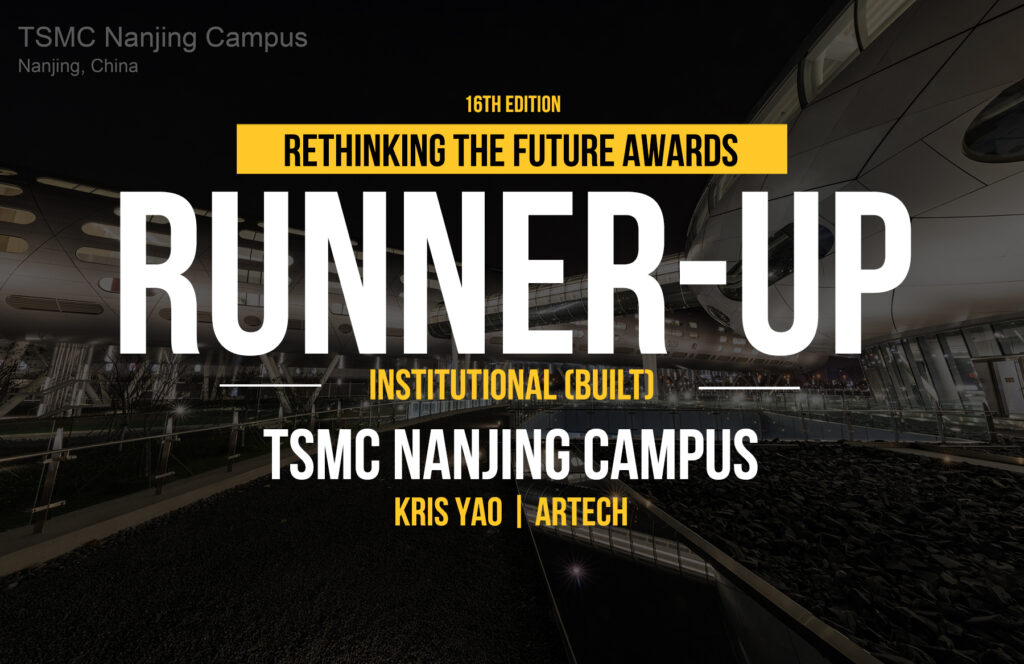The completion of the TSMC Nanjing Campus achieves a significant milestone in the establishment of high-tech enterprises in China. This futuristic complex, set amid lush vegetation, brings production and administration work together on the same campus, in an environment that maximizes productivity and also ensures the well-being of its workforce.
Rethinking The Future Awards 2024
Second Award | Institutional (Built)
Project Name: TSMC Nanjing Campus
Category: Institutional (Built)
Studio Name: KRIS YAO | ARTECH
Design Team:
Architect: Kris Yao
Project Team:
[Taipei]
Kuo-Chien Shen, Winnie Wang, Jun-Ren Chou, Yen-Hsun Li, Maria Lezhnina, Hui-Chi Chen, Po-Yen Tai, Shih-Liang Liu, Yi Ching Li, Young Kang, Wei-Hsuan Lin, Wei Tseng
[Shanghai]
Xiao-Wen Bao, Chu-Yi Hsu, Tracy Xiang, Xiao-Lu Lee, Wei-Yi Chen, Kai Wang
Area: Confidential
Year: 2019
Location: Nanjing, China
Consultants:
Structure: Chuang Wei Structural Engineering Inc.
MEP/HVAC: I. S. LIN AND ASSOCIATES
Landscape: The SWA Group; Suzhou Hezhan Design & Construction Co., Ltd.
Façade: Curtain Wall Design & Consulting, Inc., Taiwan Office; maRco façade studio
Lighting: Leuchte Lighting Design Co., Ltd.
Photography Credits: GettyImages, Kris Provoost, KRIS YAO | ARTECH, Nanjing Daily Cui Xiao, Taiwan Semiconductor Manufacturing Company, Ltd.
Render Credits: N/A
Other Credits:
Collaborative Design Institute: The IT Electronics Eleventh Design & Research Institute Scientific and Technological Engineering Corporation Limited
Contractor: Shanghai Baoye Group Corp., Ltd.; China Construction First Building(Group) Co., Ltd.; Yankey Engineering Co., Ltd.
The idea behind conceiving this complex is to treat it as though it were a single building, linking the component parts and allowing them to expand outward like ripples in a pond. The spaces are designed to encourage communication between employees, and to create diversity and interest. The horizontal layout of office spaces is designed to promote a highly efficient workflow, while landscaping and skylights provide a pleasant working environment, full of greenery and bathed in natural light. The goal is a 21st-century factory office, with an integrated approach to sustainability, technology, and user comfort. The plan consists of two cylindrical semiconductor fabrication plants (“fabs”), placed in two opposite corners of the site. An 850-meter-long tube then runs between them on a diagonal line, with a large lake at one end, while an entry rotunda strictly controls access into the chip giant’s den.
The interior of the tube appears to belong to another space and time—creating the sense of a science-fiction movie set, or an oversized spacecraft on a voyage of discovery. The colors and textures of the materials, the peculiar shape of the skylights, and the unorthodox floating compartments all speak the language of high technology.
Given a site area 100 times larger than that typical for most architectural projects, a primary design concept is to incorporate a great number of green spaces. The team envisioned the campus as “a fab in the forest,” with lush greenery surrounding an innovative and human-friendly workplace. The architectural design centers around circular volumes, referencing TSMC’s prominent role in wafer fabrication as one of the leading semiconductor manufacturers in the world. The tube, the control center, and the fab plants all take on a variation of the disk structure, each with a gray and white metal cladding, and each hovering in its own space above the forest.
In an enterprise of this kind, spontaneous exchanges between individuals and between different departments are crucial to fostering morale and sparking innovation. By extending the buildings into the forest and freeing up the ground plane, employees will be encouraged to exercise and socialize around the campus.
The lake, which stretches 180 meters in diameter, provides scenic views and enhances biodiversity by mitigating the microclimate and absorbing excess water after heavy rains. The elevated buildings also leave a generous portion of land free for existing vegetation to spread, increasing the integration of indoors and outdoors in the future.
